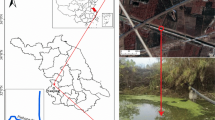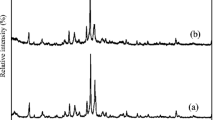Abstract
A microcosm system that included river sediment, water and different zeolite capping materials (natural zeolite, surfactant-modified zeolite (SMZ), or aluminum modified zeolite (AMZ)) was designed to study the effect of capping on the release of phosphorus and three organic pollutants (phenol, pyridine, and pyrene) from the sediment to the overlying water over the course of three month. For the same amount of the three capping materials, the efficiency of phosphorus inactivation was in the order of SMZ > AMZ > natural zeolite. The inactivation of phosphorus was mainly caused by the covering effect, co-precipitation and adsorption by the capping materials. The different zeolites gave different results for the release of phenol, pyridine, and pyrene from the sediment. When natural zeolite was used as the capping material, there was no effect on the release of pyrene and pyridine, whereas capping the sediment with SMZ or AMZ inhibited the release of pyrene and pyridine but to different extents. However, for controlling the release of phenol from the sediment, aluminum modified zeolite was the most efficient material, whereas no effects were observed when natural zeolite or SMZ were used. The different capabilities of the zeolite materials for controlling the release of different organic pollutants are related to the differences in the electrical properties of these pollutants.
Similar content being viewed by others
References
S’ndergaard M, Jensen J P, Jeppesen E. Internal phosphorus loading in shallow Danish lakes. Hydrobiologia, 1999, 408–409: 145–152
McQueen D J, Lean D R S, Charlton M N. The effects of hypolimnetic aeration on iron-phosphorus interactions. Water Research, 1986, 20(9): 1129–1135
Peterson S A. Lake restoration by sediment removal. Water Resources Bulletin, 1982, 18: 423–435
Salonen V P, Varjo E. Gypsum treatment as a restoration method for sediments of eutrophied lakes—experiments from southern Finland. Environmental Geology, 2000, 39(3–4): 353–359
Jaeger D. Effects of hypolimnetic water aeration and ironphosphate precipitation on the trophic level of Lake Krupunder. Hydrobiologia, 1994, 275–276(1): 433–444
Reitzel K, Hansen J, Andersen F Ø, Hansen K S, Jensen H S. Lake restoration by dosing aluminum relative to mobile phosphorus in the sediment. Environmental Science & Technology, 2005, 39(11): 4134–4140
Reitzel K, Hansen J, Jensen H S, Anderson F Ø, Hansen K S. Testing aluminum addition as a tool for lake restoration in shallow, eutrophic Lake Sønderby, Denmark. Hydrobiologia, 2003, 506–509(1–3): 781–787
Jacobs P H, Förstner U. Concept of subaqueous capping of contaminated sediments with active barrier systems (ABS) using natural and modified zeolites. Water Research, 1999, 33(9): 2083–2087
Ghiaci M, Kia R, Abbaspur A, Seyedeyn-Azad F. Adsorption of chromate by surfactant-modified zeolites and MCM-41 molecular sieve. Separation and Purification Technology, 2004, 40(3): 285–295
Erdem E, Karapinar N, Donat R. The removal of heavy metal cations by natural zeolites. J Coll Int Sci, 2004, 280(2): 309–314
Murayama N, Yoshida S, Takami Y, Yamamoto H, Shibata J. Simultaneous removal of NH +4 and PO 3−4 in aqueous solution and its mechanism by using zeolites synthesized from coal fly ash. Separation Science and Technology, 2003, 38(1): 113–130
Wild D, Kisliakova A, Siegrist H. P-fixation by Mg, Ca and zeolites during a stabilization of excess sludge from enhanced biological Premoval. Water Science and Technology, 1996, 34(1–2): 391–398
Bowman R S. Applications of surfactant-modified zeolites to environmental remediation. Microporous and Mesoporous Materials, 2003, 61(1–3): 43–56
Li Z, Roy S J, Zou Y, Bowman R S. Long-term chemical and biological stability of surfactant-modified zeolite. Environmental Science & Technology, 1998, 32(17): 2628–2632
Institute of Soil Science, Chinese Academy of Sciences. Physico-Chemistry Analysis of Soil. Shanghai: Shanghai Science and Technology Publishing Company, 1978, 35–45 (in Chinese)
Ruban V, Brigault S, Demare D, Philippe A M. An investigation of the origin and mobility of phosphorus in freshwater sediments from Bort-Les-Orgues Reservoir, France. Journal of Environmental Monitoring, 1999, 1(4): 403–407
Tan K H. Soil Sampling, Preparation and Analysis. New York: Marcel Dekker, 1995, 138–142
Haggerty G M, Bowman R S. Sorption of chromate and other inorganic anions by organo-zeolite. Environmental Science & Technology, 1994, 28(3): 452–458
Li Z, Burt T, Bowman R S. Sorption of ionizable organic solutes by surfactant-modified zeolite. Environmental Science & Technology, 2000, 34(17): 3756–3760
Zhang H, Zhou M, Shao K. Study on the removal of phosphate from water by modified zeolite. Environmental Pollution Control, 2005, 27(4): 137–138 (in Chinese)
APHA. AWWA, WEF. Standard Methods for the Examination of Water and Wastewater, 19th ed. Washington DC: American Public Health Association, 1995, 4–113
Wingenfelder U, Furrer G, Schulin R. Sorption of antimonate by HDTMA-modified zeolite. Microporous and Mesoporous Materials, 2006, 95(1–3): 265–271
Komarowski S, Yu Q. Ammonium ion removal from wastewater using australian natural zeolite: batch equilibrium and kinetic studies. Environmental Technology, 1997, 18(11): 1085–1097
Widiastuti N, Wu H, Ang H M, Zhang D. The potential application of natural zeolite for greywater treatment. Desalination, 2008, 218(1–3): 271–280
Subramanyam B, Das A. Study of the adsorption of phenol by two soils based on kinetic and isotherm modeling analyses. Desalination, 2009, 249(3): 914–921
Zhang J, Xie S, Ho Y S. Removal of fluoride ions from aqueous solution using modified attapulgite as adsorbent. Journal of Hazardous Materials, 2009, 165(1–3): 218–222
Zhu L, Li Y, Zhang J. Sorption of organobentonites to some organic pollutants in water. Environmental Science & Technology, 1997, 31(5): 1407–1410
Author information
Authors and Affiliations
Corresponding author
Rights and permissions
About this article
Cite this article
Sun, S., Wang, L., Huang, S. et al. The effect of capping with natural and modified zeolites on the release of phosphorus and organic contaminants from river sediment. Front. Chem. Sci. Eng. 5, 308–313 (2011). https://doi.org/10.1007/s11705-010-0561-2
Received:
Accepted:
Published:
Issue Date:
DOI: https://doi.org/10.1007/s11705-010-0561-2




